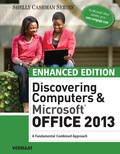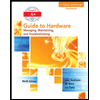
EBK ENHANCED DISCOVERING COMPUTERS & MI
1st Edition
ISBN: 8220100606922
Author: Vermaat
Publisher: YUZU
expand_more
expand_more
format_list_bulleted
Question
Chapter 6, Problem 17CT
Program Plan Intro
Volatile memory and non-volatile memory:
- Volatile memory is a type of computer memory that keeps the information when the power is on, however once the power is off the information stored in the memory is lost. This memory is also called temporary memory.
- Non-volatile is also a type of computer memory that has capability to store the information even when the power is off.
Expert Solution & Answer
Trending nowThis is a popular solution!

Students have asked these similar questions
Finally, your going to write several small javascript functions to practice with javascript core programming (basically just using javascript as a normal scripting language). For each section you can hardcode input values, and all output should go to console (we'll worry about the actual web page on Assignment 4). You can complete these all in one HTML file, or create one file for each part.
Write a C program to calculate the checksum for a given line of an IntelHex file.
To get full points, you must be able to explain to the instructor the individual parts of the IntelHex line (see below), as well as any part of your code.
Definition:The checksum is calculated as the two's complement of the sum of the individual bytes from the beginning of the line to the checksum.
Example:If you enter this string:
:10010000214601360121470136007EFE09D21901XX
You should get a checksum of 40 instead of XX.
Demonstrate the completion of the task by calculating checksums, for example, for the following strings:
:100010000C9445000C9445000C9445000C944500xx:100020000C9445000C9445000C9445000C944500xx:100030000C9445000C9445000C9445000C944500xx:100040000C9445000C9445000C9445000C944500xx
Write a program to calculate the function sin(x) or cos(x) using a Taylor series expansion around the point 0. In other words, you will program the sine or cosine function yourself, without using any existing solution. You can enter the angles in degrees or radians. The program must work for any input, e.g. -4500° or +8649°. The function will have two arguments:
float sinus(float radians, float epsilon);
For your own implementation, use one of the following relations (you only need to program either sine or cosine, you don't need both):
Tip 1: Of course, you cannot calculate the sum of an infinite series indefinitely. You can see (if not, look in the program) that the terms keep getting smaller, so there will definitely be a situation where adding another term will not change the result in any way (see problem 1.3 – machine epsilon). However, you can end the calculation even earlier – when the result changes by less than epsilon (a pre-specified, sufficiently small number, e.g.…
Chapter 6 Solutions
EBK ENHANCED DISCOVERING COMPUTERS & MI
Ch. 6 - Prob. 1SGCh. 6 - Prob. 2SGCh. 6 - Prob. 3SGCh. 6 - Prob. 4SGCh. 6 - Prob. 5SGCh. 6 - Prob. 6SGCh. 6 - Prob. 7SGCh. 6 - Prob. 8SGCh. 6 - Prob. 9SGCh. 6 - Prob. 10SG
Ch. 6 - Prob. 11SGCh. 6 - Prob. 12SGCh. 6 - Prob. 13SGCh. 6 - Prob. 14SGCh. 6 - Prob. 15SGCh. 6 - Prob. 16SGCh. 6 - Prob. 17SGCh. 6 - Prob. 18SGCh. 6 - Prob. 19SGCh. 6 - Prob. 20SGCh. 6 - Prob. 21SGCh. 6 - Prob. 22SGCh. 6 - Prob. 23SGCh. 6 - Prob. 24SGCh. 6 - Prob. 25SGCh. 6 - Prob. 26SGCh. 6 - Prob. 27SGCh. 6 - Prob. 28SGCh. 6 - Prob. 29SGCh. 6 - Prob. 30SGCh. 6 - Prob. 31SGCh. 6 - Prob. 32SGCh. 6 - Prob. 33SGCh. 6 - Prob. 34SGCh. 6 - Prob. 35SGCh. 6 - Prob. 36SGCh. 6 - Prob. 37SGCh. 6 - Prob. 38SGCh. 6 - Describe how bus width and word size affect and...Ch. 6 - Prob. 40SGCh. 6 - Prob. 41SGCh. 6 - Prob. 42SGCh. 6 - Prob. 43SGCh. 6 - Prob. 44SGCh. 6 - Prob. 45SGCh. 6 - Prob. 46SGCh. 6 - Prob. 47SGCh. 6 - Prob. 1TFCh. 6 - Prob. 2TFCh. 6 - Prob. 3TFCh. 6 - Prob. 4TFCh. 6 - Prob. 5TFCh. 6 - Prob. 6TFCh. 6 - Prob. 7TFCh. 6 - Prob. 8TFCh. 6 - Prob. 9TFCh. 6 - Prob. 10TFCh. 6 - Prob. 11TFCh. 6 - Prob. 12TFCh. 6 - Prob. 1MCCh. 6 - Prob. 2MCCh. 6 - Prob. 3MCCh. 6 - Prob. 4MCCh. 6 - Prob. 5MCCh. 6 - Prob. 6MCCh. 6 - Prob. 7MCCh. 6 - Prob. 8MCCh. 6 - Prob. 1MCh. 6 - Prob. 2MCh. 6 - Prob. 3MCh. 6 - Prob. 4MCh. 6 - Prob. 5MCh. 6 - Prob. 6MCh. 6 - Prob. 7MCh. 6 - Prob. 8MCh. 6 - Prob. 9MCh. 6 - Prob. 10MCh. 6 - Prob. 2CTCh. 6 - Prob. 3CTCh. 6 - Prob. 4CTCh. 6 - Prob. 5CTCh. 6 - Prob. 6CTCh. 6 - Prob. 7CTCh. 6 - Prob. 8CTCh. 6 - Prob. 9CTCh. 6 - Prob. 10CTCh. 6 - Prob. 11CTCh. 6 - Prob. 12CTCh. 6 - Prob. 13CTCh. 6 - Prob. 14CTCh. 6 - Prob. 15CTCh. 6 - Prob. 16CTCh. 6 - Prob. 17CTCh. 6 - Prob. 18CTCh. 6 - Prob. 19CTCh. 6 - Prob. 20CTCh. 6 - Prob. 21CTCh. 6 - Prob. 22CTCh. 6 - Prob. 23CTCh. 6 - Prob. 24CTCh. 6 - Prob. 25CTCh. 6 - Prob. 26CTCh. 6 - Prob. 27CTCh. 6 - Prob. 1PSCh. 6 - Prob. 2PSCh. 6 - Prob. 3PSCh. 6 - Prob. 4PSCh. 6 - Prob. 5PSCh. 6 - Prob. 6PSCh. 6 - Prob. 7PSCh. 6 - Prob. 8PSCh. 6 - Prob. 9PSCh. 6 - Prob. 10PSCh. 6 - Prob. 11PSCh. 6 - Prob. 1.1ECh. 6 - Prob. 1.2ECh. 6 - Prob. 1.3ECh. 6 - Prob. 2.1ECh. 6 - Prob. 2.2ECh. 6 - Prob. 2.3ECh. 6 - Prob. 3.1ECh. 6 - Prob. 3.2ECh. 6 - Prob. 3.3ECh. 6 - Prob. 4.1ECh. 6 - Prob. 4.2ECh. 6 - Prob. 4.3ECh. 6 - Prob. 5.1ECh. 6 - Prob. 5.2ECh. 6 - Prob. 5.3ECh. 6 - Prob. 2IRCh. 6 - Prob. 4IRCh. 6 - Prob. 5IRCh. 6 - Prob. 1CTQCh. 6 - Prob. 2CTQCh. 6 - Prob. 3CTQCh. 6 - Prob. 4CTQ
Knowledge Booster
Similar questions
- Write a C program that finds and prints the machine epsilon for the float and double data types. Also print the values of __FLT_EPSILON__ and __DBL_EPSILON__ defined in float.h. Reminder – the phrase data type tells how the compiler “understands” the ones and zeros you are working with. This identifies whether you are working with integers, letters, real numbers, and so on. Another definition:Machine epsilon is the "distance" between the number 1 and its immediate right neighbor. We work in binary (decimal is in parentheses): 1 + 0,1 = 1,1 (1 + 1/2 = 1,5) 1 + 0,01 = 1,01 (1 + 1/4 = 1,25) 1 + 0,001 = 1,001 (1 + 1/8 = 1,125) then, due to the limited accuracy of the computer at a certain number of decimal places, a situation arises where 1 + 0.0…001 = 1 (instead of the correct 1.0…001). Then the previous number 0.0…01 is called the machine epsilon . It is obvious that its value may be different on different computers. However, the machine…arrow_forwardWrite a program that performs a rotational bit shift to the right for a positive integer. The user enters a number, the number of bits to shift (and, if you want, the direction of the shift, but right is enough). Example:The number 9 (in binary form 1001) when rotated to the right by 1 bit becomes 1100. Tip : A bit rotation (also known as a cyclic shift) is an operation in which the bits in a binary number are shifted a certain number of places to the right or left, with bits that “fall out” at one end being returned to the opposite end. So, start with a bit shift operation. Write a few examples on paper before programming.Tip : Use the unsigned int data type.You can get the number of bits of this data type as follows: int bit_count = sizeof (unsigned int ) * 8arrow_forwardI need help resolving the following case problemarrow_forward
- Click Here for the Solution 27. Write a Program for Insertion Sort in Java. Time Complexity: O(N 2) Space Complexity: 0(1) Click Here for the Solutionarrow_forwardCounting ten tennis ball going into a box From a conveyor belt I want to write a assignment about this topicarrow_forwardI need fixing my a matlab code to find the currents USING MARTIXS AND INVERSE to find the current % At this point We Enter the Resistor values and Voltage Source Values fprintf('Provide Resistance Values for the Resistors as Requested: \n'); fprintf('===============================================\n'); R1x = input('Enter the value for R1 in kohms: '); R2x = input('Enter the value for R2 in kohms: '); R3x = input('Enter the value for R3 in kohms: '); R4x = input('Enter the value for R4 in kohms: '); fprintf('Provide voltage values for as requested: \n'); fprintf('===============================================\n'); E1 = input('Enter the value of E1 in Volts: '); E2 = input('Enter the value of E2 in Volts: '); E3 = input('Enter the value of E3 in Volts: '); fprintf('===============================================\n'); % Scaling FACTOR multiplication of resistors by 1000 (1K) each R1 = 1000 * R1x; R2 = 1000 * R2x; R3 = 1000 * R3x; R4 = 1000 * R4x; fprintf('VALUES YOU HAVE ENTERED FOR YOUR…arrow_forward
- Suppose that the two Rank methods below are added to the Skip List class on Blackboard. public int Rank(T item) Returns the rank of the given item. public T Rank(int i) Returns the item with the given rank i. Requirements 1. Describe in a separate Design Document what additional data is needed and how that data is used to support an expected time complexity of O(log n) for each of the Rank methods. Show as well that the methods Insert and Remove can efficiently maintain this data as items are inserted and removed. (7 marks) 2. Re-implement the methods Insert and Remove of the Skip List class to maintain the augmented data in expected O(log n) time. Using the Contains method, ensure that added items are distinct. (6 marks) 3. Implement the two Rank methods. (8 marks) 4. Test your new methods thoroughly. Include your test cases and results in a Test Document. (4 marks)arrow_forwardWhy do we need official standards for copper cable and fiber-optic cable? What happens without the standard?arrow_forwardWhat is the difference between physical connection (Physical topology) and logical connection (Logical topology)? Why are both necessary?arrow_forward
- There are two network models and name them while providing a couple of advantages and disadvantages for each network model.arrow_forwardhttps://docs.google.com/document/d/1lk0DgaWfVezagyjAEskyPoe9Ciw3J2XUH_HQfnWSmwU/edit?usp=sharing use the link to answer the question below b) As part of your listed data elements, define the following metadata for each: Data/FieldType, Field Size, and any possible constraint/s or needed c) Identify and describe the relationship/s among the tables. Please provide an example toillustrate Referential Integrity and explain why it is essential for data credibility. I have inserted the data elements below for referencearrow_forwardWhy do we use NAT and PAT technologies? What happens without them? What is the major difference between NAT and PAT (Port Address Translation)? please answer it in the simplest way as possiblearrow_forward
arrow_back_ios
SEE MORE QUESTIONS
arrow_forward_ios
Recommended textbooks for you
 Enhanced Discovering Computers 2017 (Shelly Cashm...Computer ScienceISBN:9781305657458Author:Misty E. Vermaat, Susan L. Sebok, Steven M. Freund, Mark Frydenberg, Jennifer T. CampbellPublisher:Cengage Learning
Enhanced Discovering Computers 2017 (Shelly Cashm...Computer ScienceISBN:9781305657458Author:Misty E. Vermaat, Susan L. Sebok, Steven M. Freund, Mark Frydenberg, Jennifer T. CampbellPublisher:Cengage Learning Systems ArchitectureComputer ScienceISBN:9781305080195Author:Stephen D. BurdPublisher:Cengage Learning
Systems ArchitectureComputer ScienceISBN:9781305080195Author:Stephen D. BurdPublisher:Cengage Learning A+ Guide to Hardware (Standalone Book) (MindTap C...Computer ScienceISBN:9781305266452Author:Jean AndrewsPublisher:Cengage Learning
A+ Guide to Hardware (Standalone Book) (MindTap C...Computer ScienceISBN:9781305266452Author:Jean AndrewsPublisher:Cengage Learning

Enhanced Discovering Computers 2017 (Shelly Cashm...
Computer Science
ISBN:9781305657458
Author:Misty E. Vermaat, Susan L. Sebok, Steven M. Freund, Mark Frydenberg, Jennifer T. Campbell
Publisher:Cengage Learning

Systems Architecture
Computer Science
ISBN:9781305080195
Author:Stephen D. Burd
Publisher:Cengage Learning

A+ Guide to Hardware (Standalone Book) (MindTap C...
Computer Science
ISBN:9781305266452
Author:Jean Andrews
Publisher:Cengage Learning
